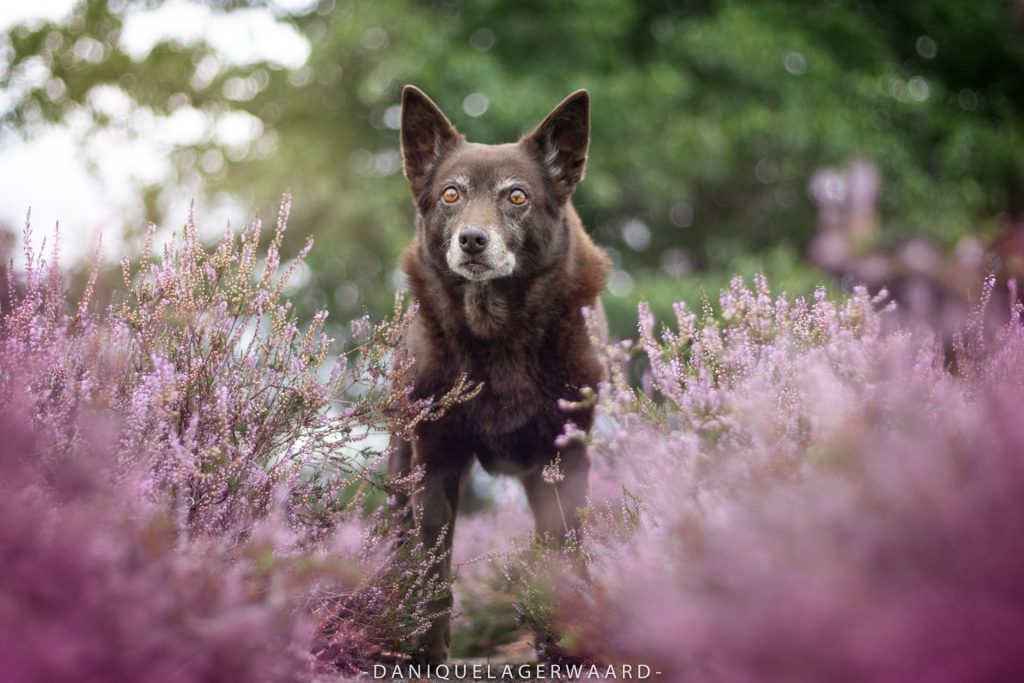Dogs do not need words to show how they feel or what concerns them. They use their bodies to do so.
Body language
Sometimes people say, ‘He’s not doing anything because he’s wagging’ but unfortunately, not every dog that moves his tail up and down is by far the friendliest dog at that moment. Sometimes dogs also wag their tails while they are scared or angry. You can use the dog’s posture as a guide to estimate his mood. In doing so, you look at the tail and ears, but also at the dog’s whole body.

Body
A dog with a high body posture feels confident and tough. It holds its head up, stands as straight as possible on its paws, and its ears and tail are also up (or as high as possible). Sometimes, when a dog suffers from ‘mixed feelings’ you see an ambivalent posture, for example, the tail tells a different story than the body.
If a dog has a high body posture but keeps its tail low, at that moment in its heart it is not as tough as it wants to pretend to be.
Similarly, when the dog ‘brushes’ (this is when the hairs on his neck and back stand up), he is trying to make it clear that he is tough. But sometimes the hairs on his neck actually stand up because the dog is (much) more scared than he wants to show.

Tail
There are three tail postures, namely neutral, high and low. This applies to all breeds and all tail shapes and tail postures. A dog has a neutral tail when he is not communicating. Then it does not clip its anus, but it does not show it clearly either. Although a Beagle carries its tail high, a Sighthound a lot lower and a Shih Tzu has it curled over its back, all breeds can cover their anus with their tail, or at least try to.
If a dog clips off its anus (often it then has its tail between its hind legs), it has a low tail position. The dog then does not exactly overflow with assurance.
A dog has a high tail if he has not clamped off his anus. When the shape and length of the tail allow it, the tail then stands up as straight as possible. With this, the dog is trying to make it clear that it feels confident and tough.
A neutral tail position is between ‘high’ and ‘low’.

Ears
Ears are another important indicator of what a dog is trying to tell its surroundings. A dog keeps its ears forward when it is confident, or alert. The other two possibilities are neutral and backwards. A dog wearing its ears neutral is not communicating. You can recognise a neutral ear position by its ear cup being slightly turned to the side. Regardless of the breed or the shape of the ears, you can always recognise the ear posture by the attachment. A dog can wear its ears backwards to all sorts of degrees and for all sorts of reasons. When it is anxious and fleeing but also when it wants to greet you in a friendly way.

Warning signals
It is certainly not true that a dog only bites when he feels confident. In fact, the majority of bite incidents are a result of fear aggression: the dog feels threatened, is afraid of something and to ward off the ‘danger’, it bites or hacks. It is rare for a dog to bite without prior warning.
If you see a dog exhibiting any of the following behaviours, it is important to be alert. He then feels absolutely uncomfortable and is trying to tell you: ‘Stop doing that, or I might bite.’
The dog stiffens in his body and stares at you.
Growling, growling barking
Wrinkling the nose, lifting the lip and showing teeth
Snapping

Dog language and children
Young children often do not understand dog language. This is because they mainly look at the dog’s head and not at the dog’s whole body. As a result, they miss information and may misinterpret what they see. An accident is then in a small corner.
If your children are older, you can watch the dog with them and point out what you see in the dog’s posture, ears and tail. If your children are younger, teach them the ten golden rules for safe dog handling.

Source: houden van honden



